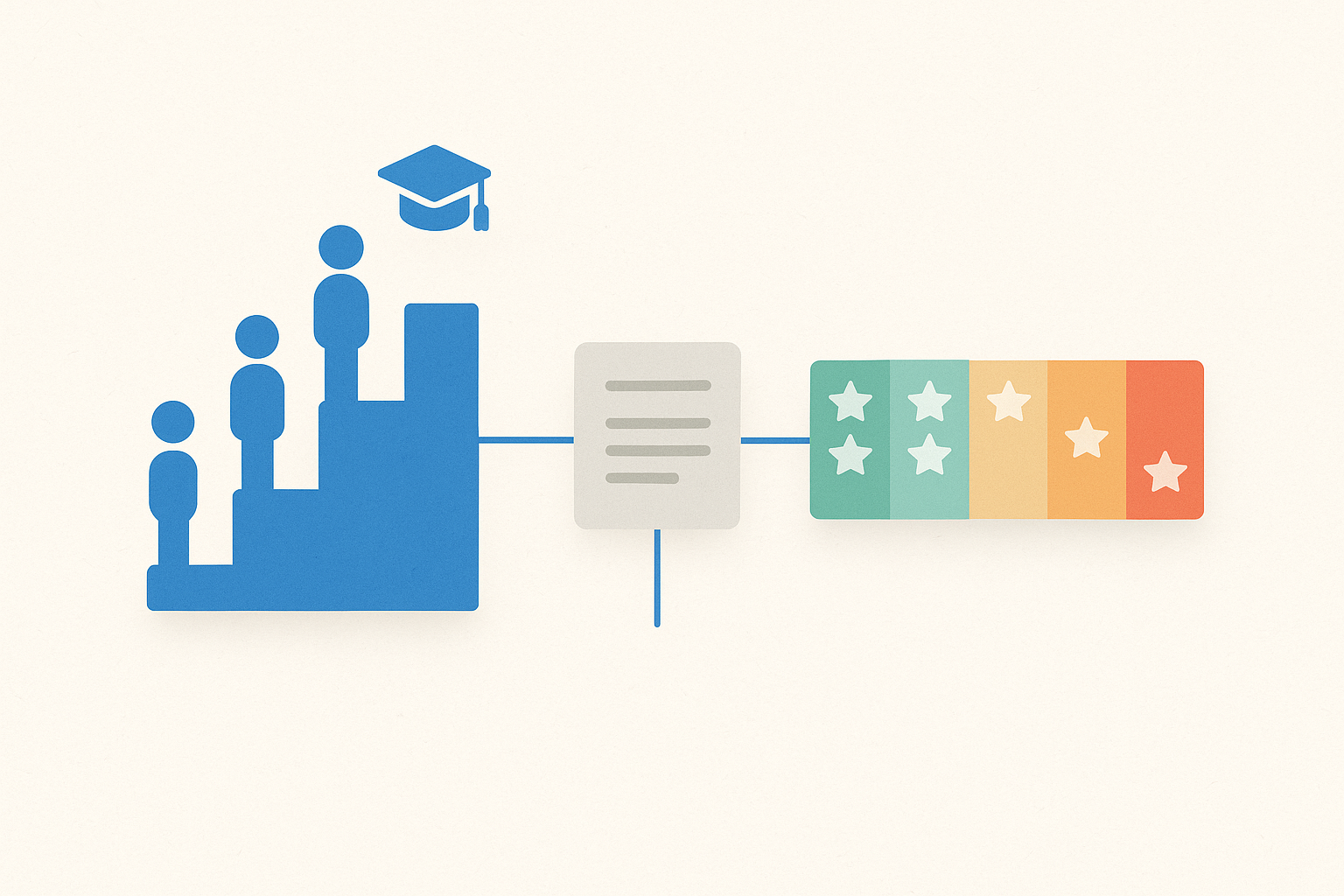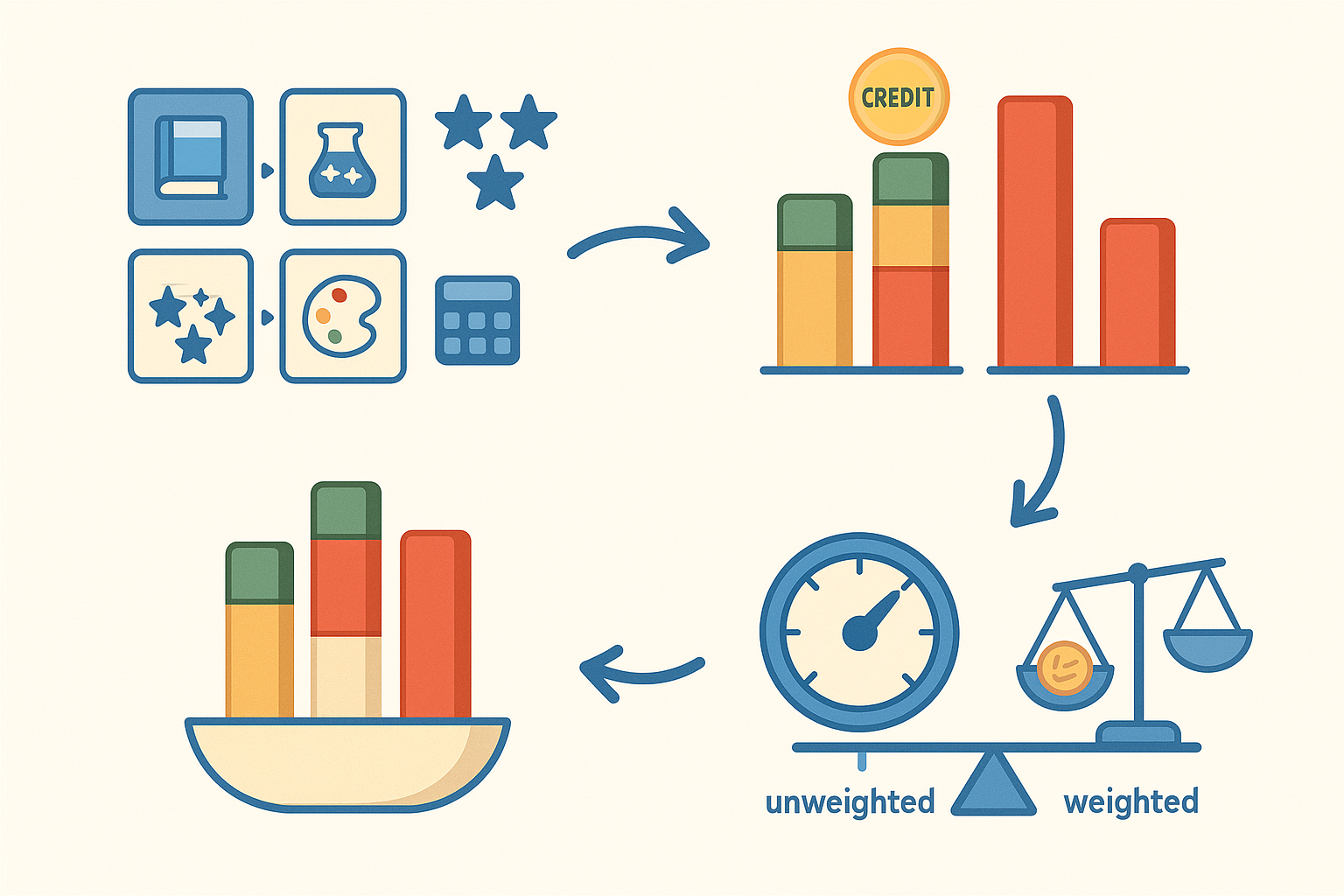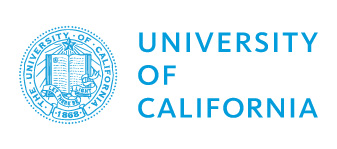High School Grades: Understanding the Basics
Understanding high school grades involves two key concepts that shape every student’s educational journey. First are grade levels representing the four years from freshman through senior year. Second are letter grades measuring academic performance from A through F. Together these systems create the framework determining college admissions scholarships and career opportunities. Parents students and educators must grasp both aspects to navigate the school system successfully.
Overview of the U.S. High School System
High school encompasses grades nine through twelve within America’s kindergarten through twelfth-grade education structure. Federal guidelines establish baseline standards while states determine specific curriculum requirements graduation criteria and assessment protocols.
Key Terminology: Grade Levels vs. Letter Grades
Grade levels refer to the four sequential years of high school known as freshman sophomore junior and senior years. These designations track student’s progress through required coursework and developmental milestones. Letter grades measure academic performance on assignments tests and overall course achievement typically ranging from A representing excellent work to F indicating failure. The school system combines both creating comprehensive student records. Transcripts display course titles alongside letter grades while counselors monitor grade-level advancement ensuring students meet graduation requirements within expected timeframes.

How High School Grades Affect Future Opportunities
Academic performance directly influences college acceptance rates with universities examining cumulative GPAs class rankings and course rigor when evaluating applications. Scholarship committees prioritize high school students demonstrating consistent excellence through high letter grades particularly in harder classes or honors courses. Beyond higher education grades impact immediate employment prospects as many employers request transcripts for entry-level positions. Strong academic records open doors to competitive internships apprenticeships and specialized training programs. Extracurricular achievements combined with solid grades create compelling narratives for admissions essays and interviews positioning students favorably for future plans.
Breaking Down the Four Grade Levels
Each school year brings distinct challenges opportunities and personal growth milestones shaping students’ academic trajectories throughout their four-year journey.
Freshman Year (9th Grade)
Freshman year typically includes children ages fourteen to fifteen years old experiencing significant transitions from elementary school environments. Academic expectations increase substantially requiring stronger organizational skills time management and independent study habits. Teachers introduce more complex concepts expecting students to synthesize information across disciplines. Successful freshmen explore various extracurricular activities discovering interests that may define their high school experience. Building relationships with teachers counselors and peers creates support networks essential for navigating challenges ahead. Early establishment of effective study routines prevents academic struggles later when coursework intensifies.
Sophomore Year (10th Grade)
Sophomore students ages fifteen to sixteen years old encounter heightened academic rigor as foundational knowledge deepens across core subjects. Many schools introduce honors or advanced placement options during sophomore year allowing motivated students to challenge themselves beyond standard curriculum. Teachers expect greater analytical thinking critical writing and problem-solving capabilities. Standardized test preparation often begins as high school students take preliminary assessments like the PSAT. Extracurricular commitments typically solidify with students assuming leadership roles in clubs or teams. Career exploration through job shadowing or vocational programs helps students connect academic learning to future aspirations.

Junior and Senior Years in Focus
The final two years of high school represent critical periods when academic performance directly impacts post-graduation opportunities and life trajectories.
Junior Year (11th Grade)
Junior year brings children ages sixteen to seventeen years old into their most academically demanding period with standardized testing taking center stage. SAT and ACT examinations occur multiple times allowing students to achieve competitive scores for university applications. Grade point averages carry maximum weight as colleges scrutinize junior year transcripts closely when making admissions decisions. Advanced placement courses reach peak difficulty requiring college-level thinking and time commitment. Students research universities attend college fairs and narrow their post-secondary options. Leadership positions in activities demonstrate maturity and commitment valued by admissions committees reviewing thousands of similar applications.
Senior Year (12th Grade)
Senior year encompasses ages seventeen to eighteen years old marking the culmination of secondary education and transition toward independence. University applications dominate fall semester requiring essays recommendations and financial aid documentation. Students maintaining strong grades through senior year demonstrate consistency and dedication despite “senioritis” temptations. Career-bound students finalize job training apprenticeships or military enlistment plans. Graduation requirements receive final attention ensuring all credits assessments and obligations are satisfied. Scholarship applications continue throughout senior year potentially securing significant financial support. Final transcripts sent to colleges verify continued academic achievement validating admissions offers.
Common Letter Grading Scales
Most American public high schools employ the traditional A through F letter grade system with A representing ninety to one hundred percent B eighty to eighty-nine percent C seventy to seventy-nine percent D sixty to sixty-nine percent and F below sixty percent. Each letter grade corresponds to quality points used in GPA calculations with A earning four points B three points C two points D one point and F zero points.
Alternative Grading Methods
Pass fail grading removes traditional letter grades replacing them with binary outcomes reducing academic pressure while maintaining standards. Competency-based assessment measures student mastery of specific skills rather than averaging performance across time periods. Standards-based grade evaluation determines achievement against predetermined learning objectives providing detailed feedback about strengths and areas needing improvement. Contract grading allows students to negotiate requirements and expectations creating personalized learning agreements. Narrative evaluations replace grades with written assessments describing student’s progress qualitatively rather than quantitatively.
Weighted GPAs and Honors Courses
Advanced placement international baccalaureate and honors classes carry additional grade point values recognizing their increased difficulty and college-level content. Weighted scales typically award five points for an A in harder classes compared to four points in regular courses. This system rewards students challenging themselves academically while protecting class rank calculations from penalizing rigorous course selection. Universities recalculate GPAs using their own formulas but appreciate transcripts showing sustained enrollment in demanding coursework.
Calculating and Tracking Your GPA
Grade point average calculation involves multiplying each course’s grade points by its credit value summing these products then dividing by total credits attempted. Cumulative GPA encompasses all classes throughout high school while semester GPA reflects single term performance. Plus minus systems add precision with A-minus earning 3.7 points B-plus 3.3 points creating finer distinctions between student achievements. Regular monitoring helps students identify trends and make strategic decisions about course selection and study efforts.

Graduation Requirements and Credit Systems
Schools utilize Carnegie units measuring instructional time with one credit typically representing one hundred twenty hours of classroom instruction. Most states require approximately twenty-two to twenty-six credits for graduation distributed across core subjects and electives.
Core Academics vs. Electives
Core academic requirements typically include four credits of English three or four credits of mathematics three credits of science three credits of social studies including history and two credits of physical education or health. Elective credits allow children to explore interests through arts foreign languages career technical education or additional academic courses. State requirements vary significantly with some mandating specific courses like economics or government while others provide flexibility. Districts may impose additional requirements beyond state minimums reflecting local priorities and community values. Balance between required and elective curriculum enables both comprehensive education and individual exploration.
State Testing and Mandatory Assessments
Many states require students to pass standardized examinations demonstrating proficiency in core subjects before receiving high school diplomas. These tests typically cover English mathematics science and sometimes social studies administered during sophomore or junior years. Students failing initial attempts receive remediation support and multiple retesting opportunities throughout the school year. Alternative demonstration methods including portfolio assessments or performance tasks accommodate different learning styles. Some states grant waivers for special circumstances while others maintain strict testing requirements regardless of individual situations. Districts provide test preparation resources ensuring all students have opportunities to meet graduation standards.
Age Ranges and Grade Placement Variations
Traditional age-grade alignment places fourteen years old children in ninth grade fifteen years old in tenth sixteen years old in eleventh and seventeen years old in twelfth grade. However variations occur through grade acceleration retention or late enrollment. International transfer students from other countries may require flexible placement based on previous education systems and language proficiency. Home-schooled children entering traditional public schools undergo placement assessments determining appropriate grade levels. Adult learners returning to complete diplomas follow modified pathways accommodating work and family responsibilities.
Academic Probation, Failing Grades, and Grade Recovery
Academic probation occurs when students’ GPAs fall below minimum thresholds triggering intervention protocols and support requirements. Credit recovery programs allow students to retake failed courses through online platforms summer school or evening classes. The public school system implements early warning systems identifying struggling students before failures occur enabling timely interventions. Tutoring mandatory study halls and progress monitoring help students improve performance avoiding probation. Alternative credit options including competency demonstrations or portfolio assessments provide additional pathways toward graduation.
Rank-Based and Curved Grading Systems
Curved grading adjusts scores based on class performance distribution ensuring predetermined percentages receive each letter grade regardless of absolute achievement. Absolute grading maintains fixed standards where ninety percent always equals an A regardless of how many students reach that threshold. Ranking systems create competition potentially motivating excellence but also generating stress and discouraging collaboration. Some schools eliminate class rank reducing unhealthy competition while others maintain rankings for scholarship and recognition purposes. Understanding grading philosophy helps students navigate expectations and advocate for fair evaluation.
Why Consistency Matters in Grading
Consistent grading policies across departments and teachers ensure equitable evaluation preventing confusion and perceived unfairness among students. Clear rubrics and transparent expectations help students understand assessment criteria improving performance and reducing anxiety. Regular communication between teachers administrators and families resolves discrepancies maintaining trust in evaluation systems. Documented policies protect both students and educators providing frameworks for addressing disputes or concerns. Consistency enables meaningful progress tracking allowing students to identify patterns and adjust strategies accordingly.
Communication and Academic Support
Open dialogue with teachers and counselors helps students address academic challenges before grades suffer irreversibly. Schools offer various support services including tutoring centers writing labs and peer mentoring programs. Online resources provide twenty-four-hour access to educational materials practice problems and instructional videos supplementing classroom learning. Parent-teacher conferences create collaborative partnerships supporting student success through coordinated home and school efforts. Early intervention prevents minor struggles from becoming major obstacles maintaining positive academic trajectories throughout high school.
Preparing for Life After High School
High school grades create permanent records influencing college admissions vocational program acceptance and employment opportunities for years beyond graduation. Final transcripts sent to universities verify continued achievement confirming enrollment eligibility and scholarship awards. Employers increasingly request transcripts especially for competitive positions or training programs requiring academic prerequisites. Strong academic records demonstrate discipline persistence and intellectual capacity valued across all post-secondary pathways. Students should view grades as investments in future opportunities maintaining focus through graduation day.
Maintaining Motivation and Balance
Effective time management prevents overwhelming workloads allowing students to maintain high performance without sacrificing mental health or relationships. Regular exercise adequate sleep and healthy nutrition support cognitive function improving academic performance naturally. Setting realistic goals celebrating incremental progress and maintaining perspective help sustain motivation through challenging periods. Support networks including family friends and counselors provide encouragement during difficult times preventing isolation and burnout. Balance between academics extracurriculars and personal time creates sustainable success patterns lasting beyond high school.
Study Tips and Resources for Academic Success
Evidence-based strategies including spaced repetition active recall and elaborative interrogation improve retention and understanding across all subjects. Libraries offer quiet study spaces research materials and technology access supporting diverse learning needs.
Leveraging Technology for Better Grades
Educational applications like Khan Academy Quizlet and Grammarly provide personalized learning experiences adapting to individual strengths and weaknesses. Video platforms offer visual explanations for complex concepts supplementing traditional textbook learning with engaging multimedia content. Organization apps help students track assignments manage deadlines and maintain study schedules preventing missed homework. Online tutoring connects students with subject experts providing immediate assistance when classroom teachers are unavailable during the school day. Parent involvement through learning management systems enables family support and accountability. Digital resources level playing fields giving all students access to quality educational support regardless of geographic or economic constraints.
Forming Peer Study Groups and Clubs
Study groups create accountability structures motivating consistent preparation while providing collaborative learning opportunities that deepen understanding through peer teaching. Academic clubs unite students with similar interests fostering intellectual curiosity beyond standard curriculum requirements through competitions research projects and guest speakers. Group study sessions reveal different problem-solving approaches expanding strategic thinking and analytical skills. Peer support reduces isolation and stress associated with challenging coursework creating positive learning environments. Leadership opportunities within academic organizations develop communication and organizational abilities valued by colleges and employers. Collaborative learning mirrors professional environments preparing students for teamwork expectations in college and careers.
Key Takeaways and Moving Forward
Understanding both grade levels and grading systems empowers students to navigate high school strategically maximizing opportunities for post-secondary success. Consistent effort across all four years builds strong transcripts supporting college applications scholarship eligibility and career preparation. Available resources including teacher support tutoring programs and technology tools ensure every student can achieve academic goals. Proactive engagement with counselors teachers and support systems prevents small challenges from becoming insurmountable obstacles. Success requires balance persistence and strategic planning throughout the high school journey.























